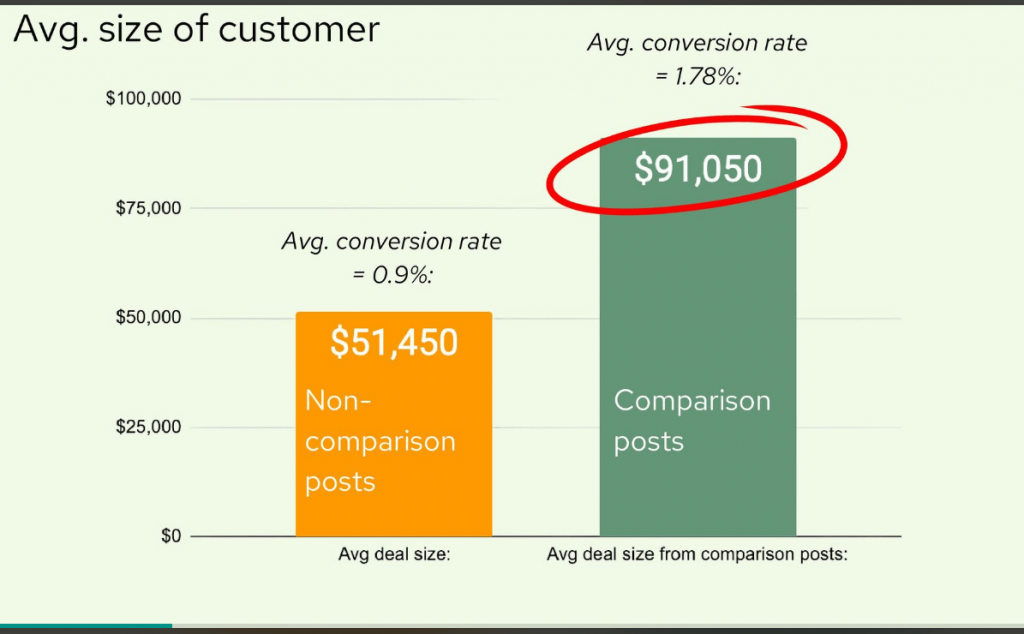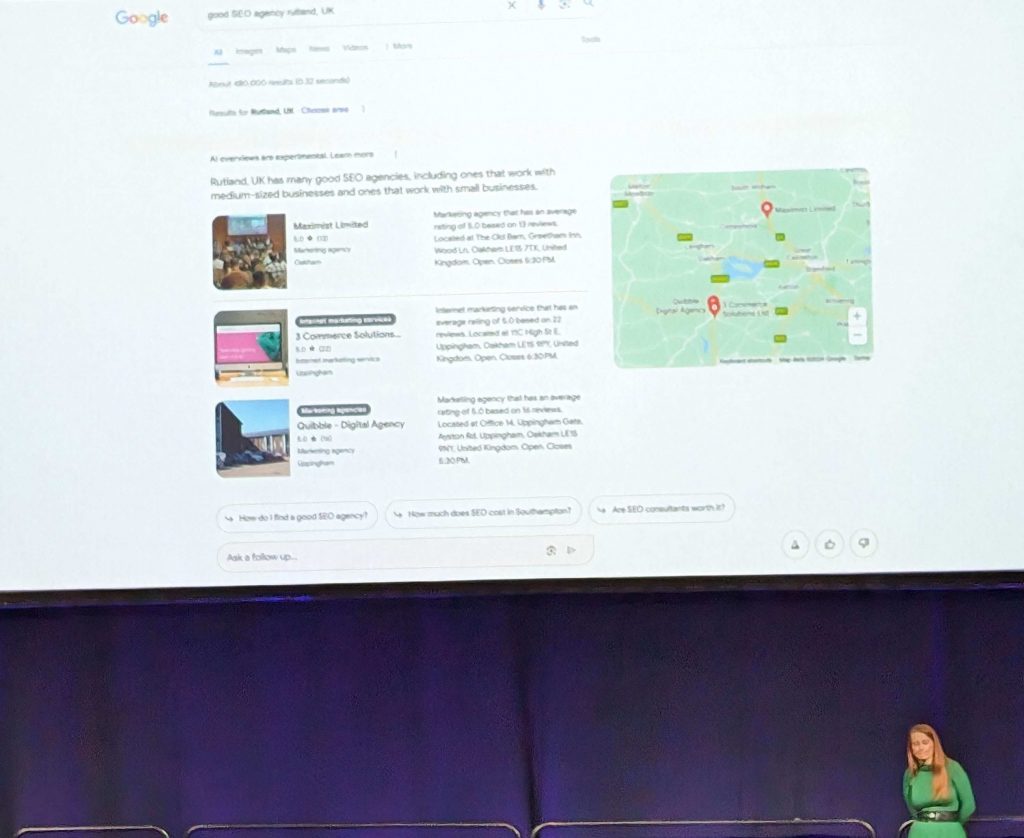Our team travelled to Brighton for the biggest SEO conference in the world: BrightonSEO. It’s come a long way from a room above a pub, they say…
Because of the sheer quantity of talks, tips and strategies shared at this event, we can’t include everything. This is the first blog in a new series which will cover the most interesting insights, organised by topic. First, we’ll look at content strategy.
What kind of content will you focus on? How much of it will you produce? Across which platforms? How will you measure success?
A good content strategy is:
- Informed by current content performance
- Targeted using audience profiles
- Time-bound and Measurable
New Thinking on Content Strategy
With the launch of Google SGE coming this month, and search intent forming a much bigger part of the picture than in previous years, there is a lot to discuss this year. The main question on our minds was:
“How do we plan content that creates resilient organic traffic for our clients during all this change?”
Three speakers in the Content Strategy session had different takes on what SEO content writers should prioritise.
1. Preparing for Google SGE
Anna Morrish of Quibble shared content strategies for AI-integrated search. Google SGE will show AI-generated answers before organic website results. As a result, SEO’s are currently analysing how to mitigate losses in organic traffic, which Morrish says may drop by 20-60% in May 2024.
From analysing results during the SGE trial period, Morrish suggests the main areas to focus on will be category content and Google reviews. These are the main decision-making areas that are summarised by SGE, with links to information sources included in the answers.
Using ‘labyrinth movie gifts’ as a sample search query, Morrish demonstrated that SGE will suggest various expansions of the query by category. If category content on eCommerce sites lists helpful information that other providers don’t, the SGE may list your categories over others and cite your website as a source.
She also showed that local business reviews appear as a summary in Google SGE. Like category content, if your Google Reviews include specific language about services, the SGE experience will be more effective.
We’re looking at the questions audiences are asking about our clients’ products and services to understand content gaps and create content to fill them.
Research from STAT (Moz) points to a net benefit for SEOs. The data suggests that users in the US rarely see SGE results by default. Instead, they are triggered by “Generate” buttons, giving users control.
This means the top 5 results will not be completely obscured by the “Generate” button, so your high-ranking pages will still have value.
They also found that sites referenced in 55% of SGE results “did not actually appear in the top 10 organic results for the same SERP.” As we know from the introduction of Featured Snippets and People Also Asked, search users look around for context, even when Google is feeding them key information directly. Lower-ranking pages with specific and useful information may still gain clicks as citations in the SGE’s references.
3 key tips to prepare websites for Google SGE:
Here’s how we can make sure websites are ready for this AI integration and minimise drops in organic traffic.
- Keep content short and to the point.
- Make it personal where possible
- Encourage specific reviews for local businesses
The introduction of AI content isn’t necessarily going to cause a huge shift in metrics. SGE will only appear for users who log into a Google account in their browser, and won’t necessarily show up automatically. This feature is not yet available to more than a ‘small slice’ of UK users, so stay tuned for more detail as the roll-out progresses this month.
2. Target Users who are Ready to Buy with Comparison Posts
Araminta Robertson of Mint Studios shared data on real content that mentions competitors without directing traffic away. Conventional wisdom has been that writing about competitors will simply make users aware of other options and potentially lose sales. Robertson skewers this logic as old-fashioned.
“Customers already know about your competitors” she says, and backs it up:
- They’re doing 3x the research they were doing in the 2010s
- They’re seeing targeted ads the second they start searching for products like yours
- With smartphones, searching multiple sites and products at once is quicker and easier.
Robertson’s rationale for prioritising comparisons was convincing: Comparison posts double conversion rates, and double the size of the deals they lead to. 
This is because comparing your solution to your competitors’ targets people who are ready to buy. At this funnel stage, people crave comparisons, as shown by the success of sites like Compare the Market.
Why does this work?
Giving potential buyers a direct comparison between your product and a competitor’s alternative saves them time and cognitive energy.
“You don’t want to write an article that says “Our product is the best” full stop.”
The key is to show the situation in which your solution is best. Robertson suggests structuring the article into three parts.
- First, make a solid case for your product. Use technical details, the problems it solves, and testimonials to show why this product works for the situation.
- Give the straightforward facts of a competitor’s product. You can avoid being overly negative or critical, and you can show the situations in which these products might surpass your own.
- Do the same for a third competitor. Give just the facts.
To Make Comparison Posts Work: Name the Elephant
Robertson also advised writers to build trust with the reader by “naming the elephant in the room”: bias.
By being up-front and acknowledging that we think our product is the best, we can disarm the reader’s cynicism. This helps them assess the products with more openness and presents your brand as honest and down to earth.
3. Sustainable Content is Better SEO
Fiona Brennan of Indie Essentials broke the silence on the environmental impact of server farms. To sustain the internet as it is, with 15 million pieces of content (or 328.77 million terabytes of data) generated daily, millions of servers are running day and night. This uses energy and creates an enormous carbon footprint.
Brennan argued that creating huge volumes of content on every conceivable channel is also unsustainable in human terms, sharing that 50% of content writers are burnt out.
The solution to both of these issues is to create less. Instead:
- Optimise existing content. Use what you have before creating more.
- Improve CRO to make the pages that perform well bring people to the products.
- Reduce your channels to include only the channels that make sense for your target market.
- Don’t be afraid to pivot future messaging towards the audience you’re gaining, rather than trying to target everyone.
We already know that with content, less is more. It’s with gratitude that we share Brennan’s approach as a people-first strategy for content creators as well as internet users.
Content Strategy is Changing: for the better.
We’re relieved, frankly, that SEO content doesn’t need to be long-form, rehashing existing information or produced ad infinitum anymore. It’s exhausting, for content writers and SEOs alike. The new content strategy ushered in by the Helpful Content Update, SGE and anti-spam policies favours lean, specific and informative writing.
When we rewrite content for a client’s website, we start with a content audit. By creating an inventory and analysing each page, we can prioritise high-value pages that need work. Out-of-date, irrelevant pages, such as old blog posts, can be pruned or updated, and any new content is as lean as possible.
A few years ago, the conventional wisdom was to add as much content as possible. This means most websites that have had SEO in the past may need to reduce and distil the information they display to continue seeing good results.
If your website’s rankings have been declining, get in touch for an SEO audit with eSterling.


